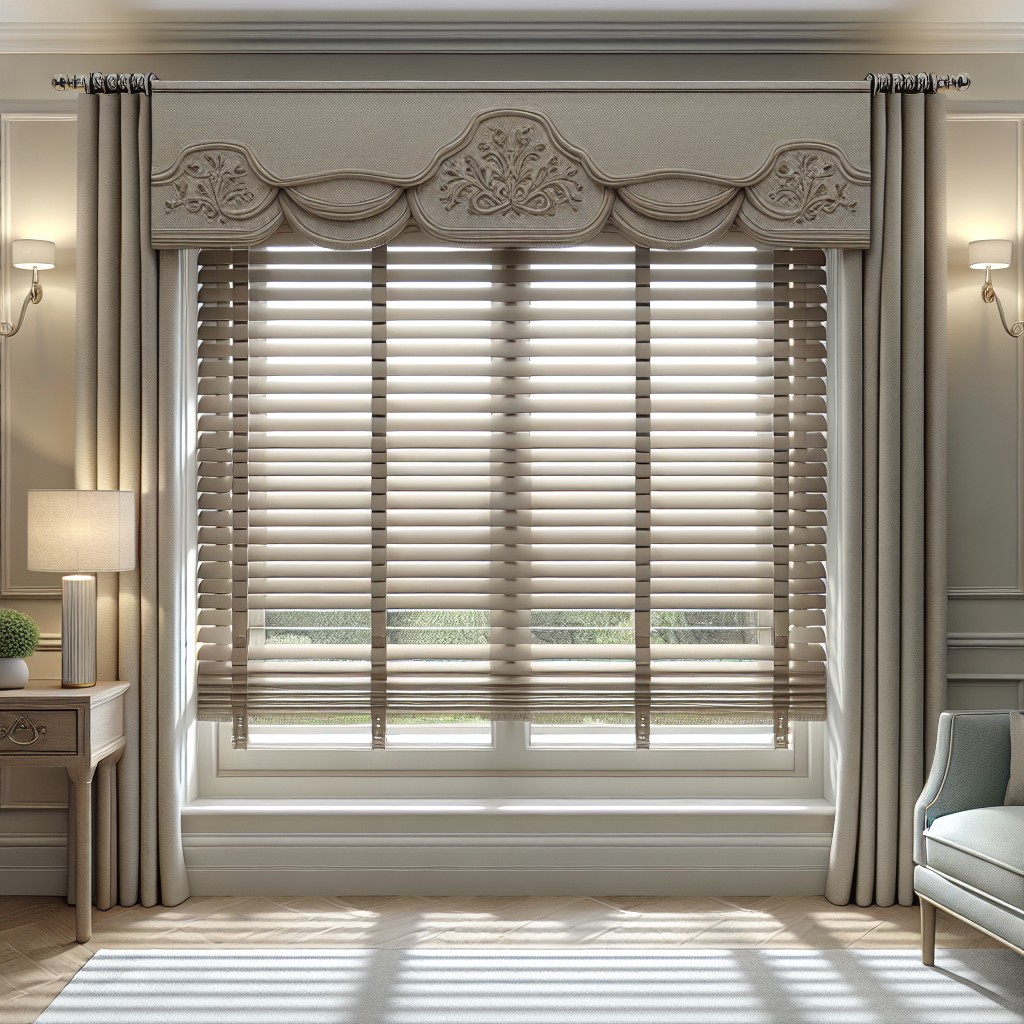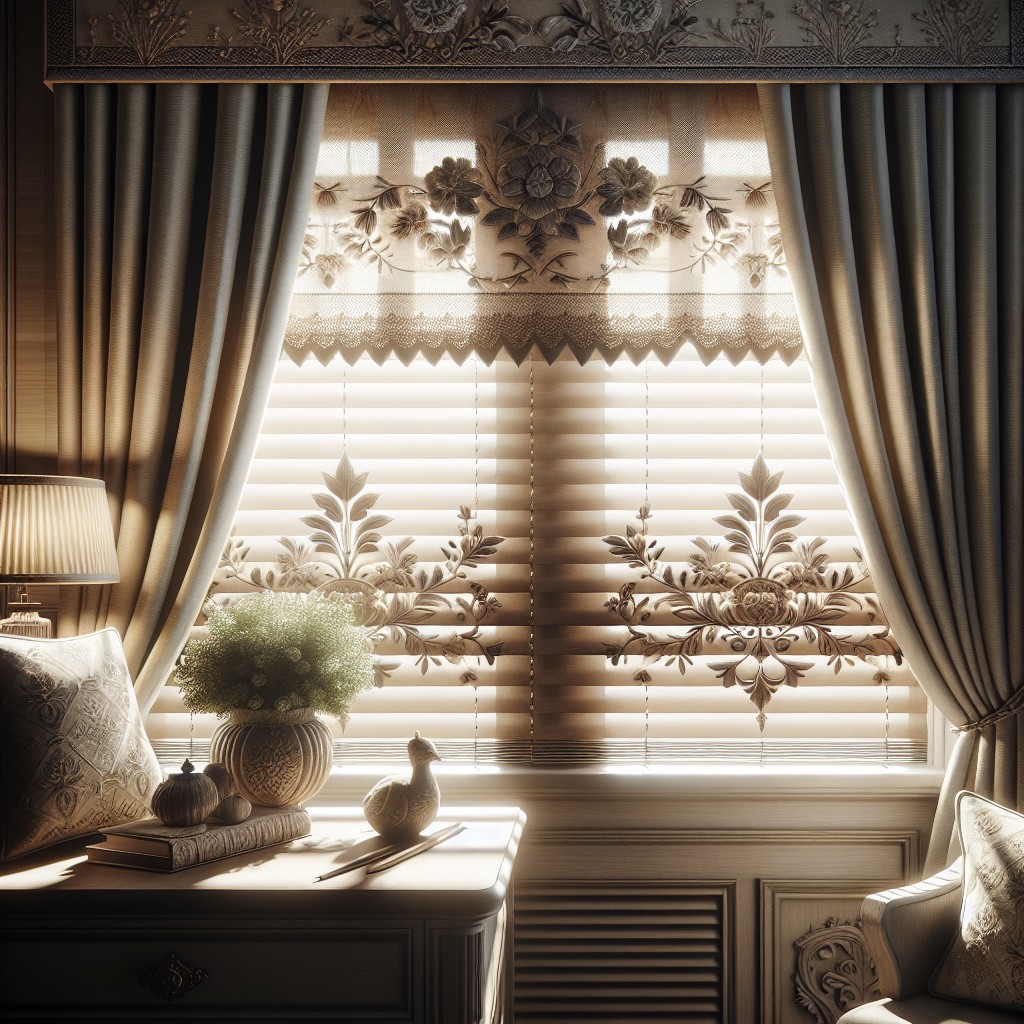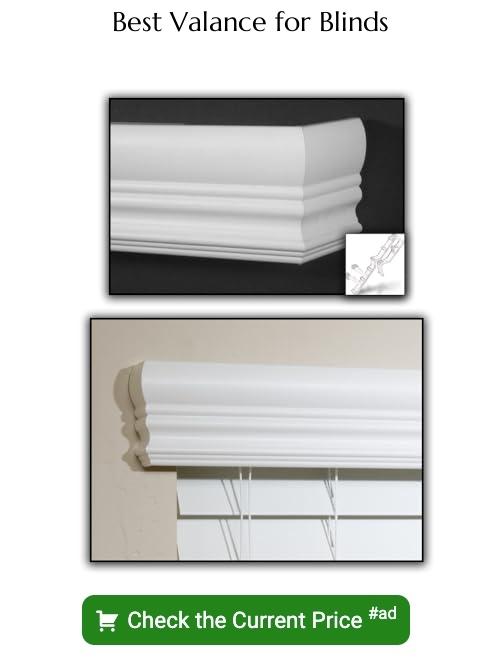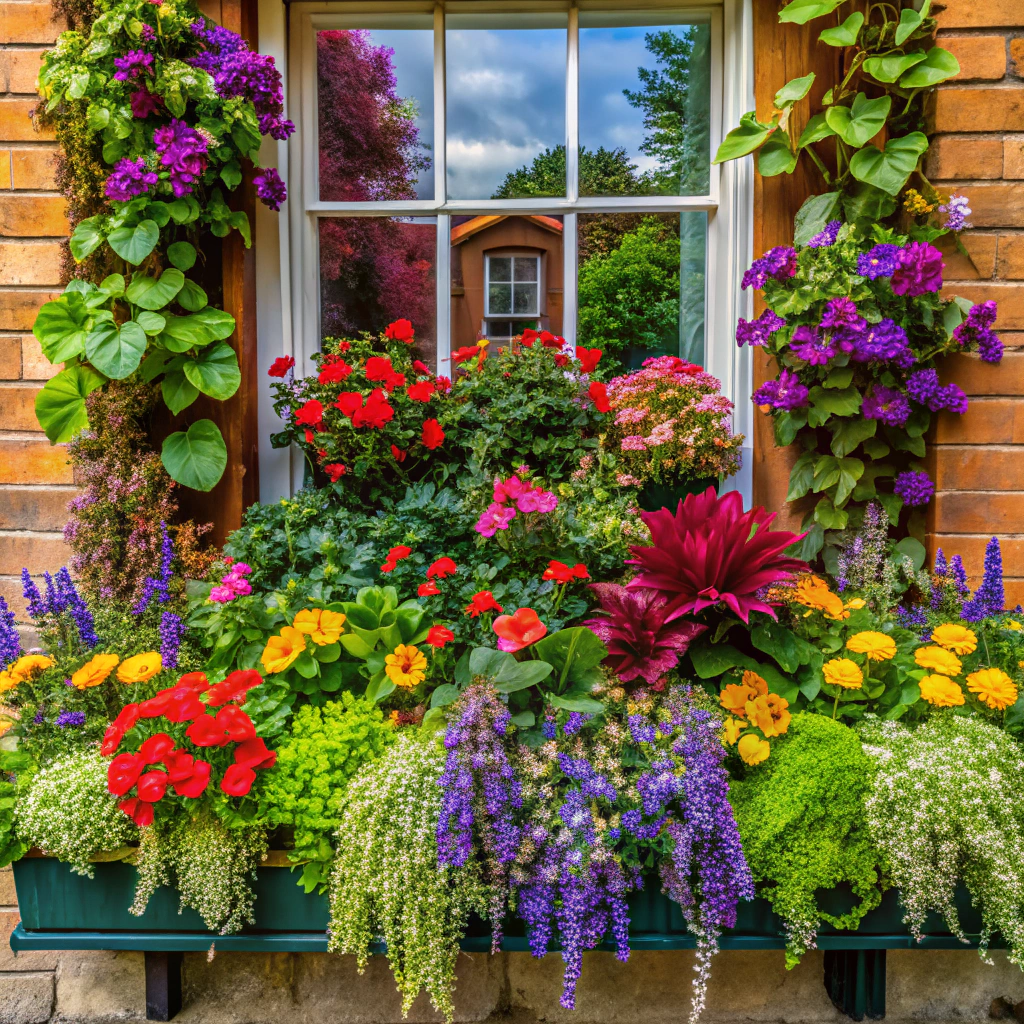Uncover the aesthetic and practical reasons to consider a valance for your blinds, because utilizing this simple accessory can completely transform the ambiance of your rooms.
Key takeaways:
- Valances are decorative pieces that hang across the top of windows.
- They conceal curtain rods, blind mechanisms, and other hardware.
- Valances add elegance, personality, and a finished look to blinds.
- There are different types of valances, such as cassette and fascia.
- Valances soften the window appearance and offer design versatility.
Definition of a Valance

A valance is a decorative piece of fabric or other material that hangs across the top of a window. It serves the purpose of concealing curtain rods, blind mechanisms, and other window treatment hardware, providing a clean and cohesive aesthetic.
While often paired with curtains or drapes, valances are also used with blind setups to add a touch of elegance and personality to the window dressing. They can be made from a wide range of materials including wood, fabric, metal, or plastic, depending on the desired look and function.
Valances come in many styles, from sleek and modern designs to more ornate and traditional options, allowing them to blend with various interior decors.
Purpose of Adding a Valance to Blinds

Valances serve a dual role in enhancing window treatments. They effectively conceal the mounting hardware and top rail of blinds, providing a clean, streamlined look. Beyond functionality, valances add an aesthetic touch, elevating the room’s decor with a polished, finished appearance.
Their design creates an illusion of height, drawing the eye upward and making windows appear larger. Additionally, they offer an opportunity for a pop of color or pattern, contributing to the room’s overall design scheme.
Types of Window Valance for Roller Blinds
Cassette valances are neatly contained units that house roller blinds, providing a sleek, unified appearance. These are well-suited to modern interiors and can effectively hide the rolling mechanism.
Squared cassette valances offer a more geometric and structured look. Their sharp lines complement contemporary design schemes and make for a discreet cover that melds seamlessly with the surrounding architecture.
Fascia valances present a flat, front-facing panel that covers the roller mechanism. Typically made of metal or plastic, they are a popular choice in both residential and commercial settings for their clean lines and unobtrusive design.
Each type of valance has the potential to conceal the mechanical elements of roller blinds, unify the room’s aesthetic, and serve as a stylish accent to the window treatment ensemble.
Cassette Valance
A cassette valance encases the top of blinds in a sleek, rectangular housing. This type of valance is integrated into the headrail, which allows for a clean, cohesive look with the blinds it accompanies. Ideal for maintaining a minimalist aesthetic, a cassette valance hides the mechanical parts and rolling mechanisms of blinds, leaving a smooth, unobtrusive finish.
Key points:
- Conceals working parts of roller shades and provides a polished appearance.
- Often used in contemporary or modern decor due to its streamlined design.
- May come with an optional matching fabric wrap to coordinate with the blinds.
- Easy to clean, as the enclosed design limits dust accumulation.
- Supports a uniform look across multiple windows, particularly in commercial or office settings.
Squared Cassette Valance
Squared cassette valances provide a modern and streamlined look to window treatments. They feature a box-like structure that neatly encases the roller mechanism of blinds, resulting in a crisp, tailored appearance. This style is particularly suited for contemporary and minimalist decor.
The squared edges align well with the straight lines of windows and blinds, offering a cohesive look. Moreover, squared cassette valances can serve as a visual anchor in a room, creating a sense of balance and structure. They are available in a variety of materials and finishes, allowing customization to match or contrast with the existing blinds and room decor.
Fascia Valance
A fascia valance is a contemporary style that offers a crisp, clean look to your window treatment. It consists of a flat, rectangular piece of finished material, typically metal or vinyl, that encases the top of the blinds, thereby hiding the roller mechanism or headrail. This type of valance is well-suited for both residential and commercial settings where a minimalist aesthetic is desired.
- Designed for a sleek profile, it emphasizes straight lines and smooth surfaces.
- Ideal for spaces where architectural detail needs to be highlighted without additional fabric patterns or textures.
- Mountable inside or outside the window recess, it’s flexible for various window configurations.
- Easily detachable, cleaning and updating your blinds’ look become practical tasks.
Advantages of a Valance
Valances serve both aesthetic and functional purposes in a window treatment setup. By effectively covering the top bracket and mechanisms of blinds, they present a polished look that can harmonize with the room’s decor.
In addition to concealing undesired hardware, valances add a softening touch to windows, mitigating the starkness of the blinds and creating a finished appearance. They also grant homeowners flexibility in design, allowing for a change in style without needing to replace the entire window treatment.
With a range of materials and patterns available, valances can be matched with different interior themes, from classic to contemporary.
Cover Up Hardware
A valance serves as a decorative cover that conceals the mechanical elements at the top of window blinds. Whether the blinds are operated manually or motorized, this addition can make the entire window treatment look more polished by hiding tracks, mounting brackets, and headrails.
By strategically masking these components, valances create a seamless aesthetic, allowing the beauty of the blinds to take center stage. This can be particularly valuable in formal areas where exposed hardware might detract from the room’s overall elegance.
Additionally, for blinds that feature cords or chains, a valance can help to keep these out of sight, contributing to a safer environment for children and pets.
Soften Window Appearance
Adding a valance creates a smoother, more polished look by obscuring the mechanical components of blinds which can sometimes appear harsh or industrial.
A valance can introduce color, texture, or patterns, which can complement your room’s decor and create a cohesive design aesthetic.
It brings an element of softness to the window treatment by draping elegantly over the top, breaking up the straight lines of the blinds and adding a decorative touch that can enhance the overall ambiance of a room.
Valances can also balance the proportions of the window, making it appear larger or more significant, thus contributing to the room’s visual harmony.
Versatility in Design
Valances elevate the aesthetic of your room by providing a variety of design options. They come in a broad spectrum of materials, from fabric to wood, which allows them to blend seamlessly with any decor style—whether it’s traditional, modern, or rustic.
With fabric choices ranging from sheer to heavy velvet, and patterns from solid colors to ornate prints, there is a valance to suite every taste and window treatment need. Tailored for custom fits, valances ensure cohesive design flow throughout a space, matching or complementing existing furnishings and color schemes.
They also permit creative layering, with possibilities of pairing with different types of blinds or drapes to add depth and dimension to your windows. The adaptability of valances means they can satisfy both decorative ambitions and functional requirements, doubling as a concealment solution for less visually appealing hardware or as an additional insulation layer, enhancing energy efficiency.
Valance Styles
Rod pocket valances slide easily onto a curtain rod through a pocket sewn at the top, providing a gathered look.
Tab top valances feature loops of fabric at the top edge that are threaded onto a rod, creating a series of draped fabric segments with a casual vibe.
Flat valances hang straight down from the rod with no gathers or ruffles, offering a clean and modern appearance suitable for a variety of decor styles.
Rod Pocket Valances
Rod pocket valances feature a pocket that runs across their top edge. This pocket is designed to slide directly onto a curtain rod, making them one of the easiest styles to install. The fabric above the pocket creates a ruffled or gathered appearance, introducing texture and an element of casual elegance to the room.
These valances are especially well-suited for traditional or rustic home decors due to their classic look. They can be made from a variety of materials including cotton, linen, and polyester, offering flexibility to match different interior styles. Moreover, the simple design allows you to incorporate patterns or prints to coordinate with the existing room theme without overwhelming the space.
Care for rod pocket valances typically involves regular dusting and occasional washing, depending on the fabric. Always refer to the care instructions provided to ensure the longevity of the fabric’s color and quality.
Tab Top Valances
Tab top valances feature loops of fabric at the top edge that hang from a curtain rod, offering a casual yet elegant look. These valances easily slide along the rod, allowing for quick removal and hassle-free laundering. The exposed rod with tab tops adds a decorative element and is ideal for emphasizing themed or stylized curtain rods.
When pairing with blinds, tab top valances provide an uncluttered appearance, making them suitable for a variety of interior design schemes, from rustic to modern decor. They can be created using a range of fabric types, patterns, and colors, providing flexibility in matching them with the existing room aesthetics. The spacing and size of tabs can be adjusted to create different visual effects — fewer tabs for a minimalist feel or more tabs for a fuller look.
Flat Valances
Crafted from a single piece of fabric, flat valances offer a clean, uncluttered look that complements contemporary and minimalistic decor seamlessly. They drape straight down, are easy to install, and work well in spaces where simplicity is key.
Since they lack ruffles or folds, they can showcase bold patterns or colors without overwhelming the space. This style also allows for easy pairing with various types of blinds, from roller shades to Venetian blinds, making them a versatile choice for any room.
When opting for a flat valance, consider the fabric weight—lighter materials will offer a softer look, while heavier fabrics can provide a more structured appearance.
Installation of a Valance
Installing a window valance is a straightforward process that can dramatically enhance the overall look of your window treatments. Here are the steps involved:
1. Gather Tools and Materials: You will need a measuring tape, pencil, drill or screwdriver, screws, wall anchors (if necessary), and the valance bracket kit that came with your valance.
2. Measure the Width: Measure the width of your window to determine the placement of the valance brackets. Mark the spots where the brackets will go, ensuring they are level and aligned.
3. Install Brackets: Using the drill or screwdriver, secure the valance brackets into place. If you are drilling into drywall without a stud behind it, use wall anchors to provide additional support.
4. Attach the Valance: Once the brackets are installed, clip or slide the valance onto the brackets according to the manufacturer’s instructions.
5. Adjust for Fit: Some valances allow for slight adjustments. If yours does, make sure it is centered and even on both ends for a professional finish.
By following these steps, you can confidently install your window valance and enjoy the aesthetic and functional benefits it brings to your space.
FAQ
Is a valance necessary with blinds?
No, a valance is not necessary with blinds, but it can enhance the overall aesthetic and provide additional stability.
What is the purpose of a window valance?
The purpose of a window valance is to create a decorative border, improve insulation against temperature changes, and prevent drafts.
What does a valance look like?
A valance is a custom fabric accent that sits at the top of the window, offering a casual or formal appearance depending on the fabric used, and typically matching or complementing the window treatment and room decor.
When should you use a window valance?
A window valance can be utilized at any time in any room to add an interesting aesthetic element, provided the installation is done correctly.
How is a window valance installed with blinds?
A window valance is installed with blinds by mounting the headrail of the blinds directly onto the interior of the window frame, then attaching the valance over it with clips or a Velcro strap.
Can a window valance be used with any types of blinds?
Yes, a window valance can be used with any types of blinds, including vertical, venetian, roller, and panel blinds.
What are the different styles of window valances available?
Different styles of window valances include swag, box pleat, balloon, scarf, buttoned-up, ruffled, and roll-up valances.
Recap




